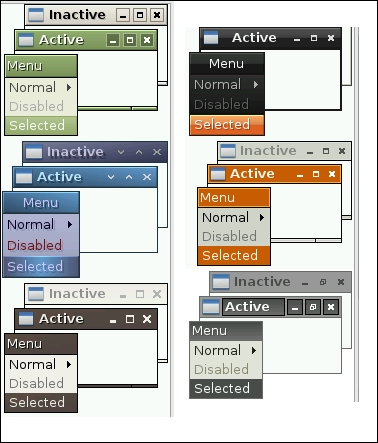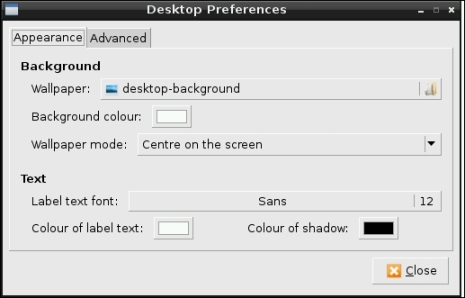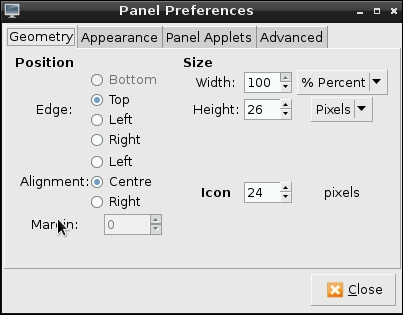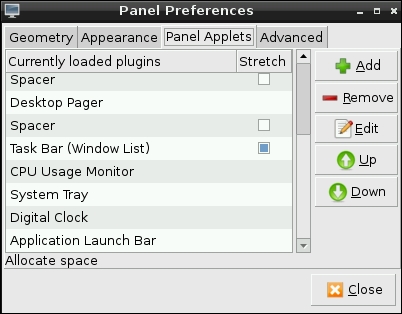Xfce can be customized in many different ways. This allows you to personalize the desktop environment to look the way you want it.
The first thing that you should check when Raspbian boots to the desktop is whether the resolution your Raspberry Pi is using is suitable for your monitor. Raspbian attempts to select the correct resolution on your TV or monitor to make sure that everything looks like it should, but sometimes it is unable to do this correctly. You will be able to recognize that the resolution is wrong if the image on the screen looks blurry or doesn't fit properly.
You can change the resolution to suit your monitor using the Monitor Settings application in the preferences section.

Monitor settings
It might take a few goes to find the best resolution for your monitor or TV, but it is definitely worth it! You are also able to customize the refresh rate of your monitor if you still have problems getting the display looking right.
Almost every part of the Raspbian desktop can be customized, from creating extra panels to changing the default colors and fonts.
To get started, click on the main menu and inside the preferences sub menu you will see Customise Look and Feel. In this window, you are able to change almost everything from the default styles, colors, icons, and fonts to many other things.

Customise look and feel dialog
One of the easiest things to customize is the style of the different UI elements. There are many different styles that you can choose from:

Openbox is the default Windows manager that is bundled with Raspbian. A Windows manager is responsible for the placement and appearance of Windows in a desktop environment.
You can also customize your desktop using Openbox Configuration Manager, which is found in Preferences.

The Openbox Configuration Manager
You can install any themes designed for Openbox on your Raspberry Pi. There are many different themes preinstalled that you can choose from, or you can download many themes from the Internet. One such website that you can download themes from is http://box-look.org/.

Examples of the different Openbox themes
Many other parts of the Raspberry Pi desktop can be customized using the Openbox Configuration Manager, ranging from how the titles of all the windows are displayed to how you resize the windows.
The best way to see all the ways in which you can customize your desktop is to have a play!
The desktop background of your Raspberry Pi can be easily customized. To do this, simply right-click on an empty spot on your desktop to bring up a menu:

The desktop context menu
From the menu, select Desktop Preferences; this will bring up the Desktop Preferences menu.

The desktop preferences dialog
The desktop preferences menu lets you customize all sorts of things on the desktop. To change the default image that you see on the background, simply click on the select box labeled Wallpaper, and choose the picture you want. There are several pictures included in Raspbian to get you started, and you are able to get more from other places on the Internet.
You can change the background color on the desktop, and you can also view how the background image is displayed by changing the Wallpaper mode and Background color.
Panels are a really nice feature of Xfce. Panels can be added to any part of the screen, and they can contain any number of panel items, which can be anything from a button to a graph.
A customized panel
By default, you have one panel at the bottom of the screen. You are able to add as many of these as you want in any position. Be careful before you add too many, as too many panels can slow down your Raspberry Pi!
To add a panel, right-click on an empty spot on a panel that you already have and select Create New Panel. The corresponding dialog will appear.

The create panel dialog box
From here, you can configure almost any aspect of your new panel, including its position, width, and appearance. You can also add panel items. When you click on Close, your new panel will appear, ready for you to add panel items to.
You can customize the size and shape of the existing panels by right-clicking on the panel that you want to resize and selecting Panel settings. This will bring up the same preceding dialog.
By default, there are only a few panel items on the main panel. There are almost twenty other types of panel items available by default in Xfce. It is really easy to add some of these to your panels.
To do this, right-click on the panel that you want to add the panel items to and select Add / Remove Panel Items.

Adding panel items
Some of the widgets that you are able to add include a volume control, custom menu, and a spacer to help you lay out all the panel items that you have.
